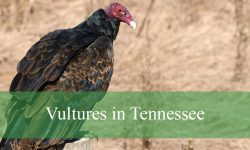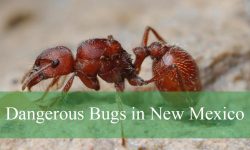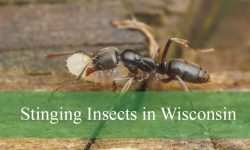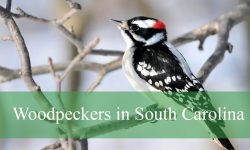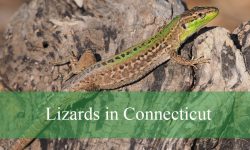Unveil the intriguing world of 10 diverse types of green caterpillars with black heads through captivating visuals. Learn about their distinctive characteristics, habitats, and ecological significance in various environments.
What is the typical habitat of green caterpillars with black heads?
The typical habitat of green caterpillars with black heads encompasses a diverse range of natural and man-made environments. These distinctive caterpillars can be commonly spotted thriving in lush gardens, where an abundance of vegetation provides an ample food source for their voracious appetites.
Additionally, they find their place amidst the rich biodiversity of dense forests, where they play a crucial role in the complex web of life, contributing to the intricate balance of the ecosystem.
Moreover, these resilient creatures have adapted to survive in agricultural fields, often becoming a familiar sight among the crops, where they fulfill their role in the natural cycle.
Different Types of Green Caterpillars with Black Heads
1. Long-Tailed Skipper Caterpillar
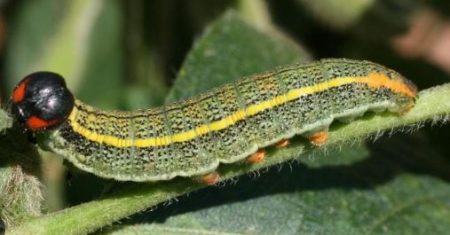
Urbanus proteus, often known as the Long-Tailed Skipper Caterpillar, has a yellow-green body with a pronounced black dorsal line. Its head is striped in black, maroon, yellow, and reddish-orange, and it frequently has an orange or yellow patch that is visible on both sides. The primary food source for these caterpillars is vine legumes, which includes blue peas, wisteria, hog peanuts, and beggar’s ticks. In addition to Florida, southern Texas, southern California, southern Arizona, eastern Kansas, and southern Illinois, they are frequently found in Central America, Mexico, and the West Indies.
2. Horace’s Duskywing Caterpillar
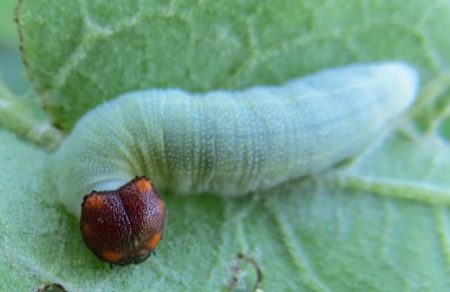
Horace’s Duskywing Caterpillar, also known as Erynnis horatius, is blue-green with white spots and a dorsal stripe. After pupating, they become butterflies, and gardens, woodlands, wetlands, and forested yards are frequent places to find them. The main food source for these caterpillars is a variety of oak tree types, including live oak, myrtle oak, turkey oak, and water oak. They are observable in Michigan, New York, and South Dakota.
3. Luna Moth Caterpillar (Actias luna)
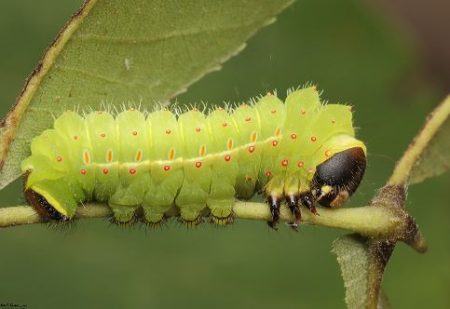
Actias luna is the scientific name for the caterpillar of the luna moth. The adult luna moth and the caterpillar have the same name. Its name means “active moon” in Latin. Furthermore, larvae of luna moths are truly diurnal, despite the fact that as adult moths they are most active at night. On the other hand, the patches on the luna moth’s hindwings that resemble the moon give it its name. The fake eyes, or eyespots, of concentric rings that mimic the rings of the planet Saturn are the source of the family name Saturniidae.
4. Wild Indigo Duskywing Caterpillar

Erynnis baptisiae, also known as the Wild Indigo Duskywing Caterpillar, grows from orange-white to light yellow-green, with short hairs and white tubercles. They are frequently seen on roads, train tracks, and open forests, where they primarily eat indigo and crown vetch. These butterflies are expanding their habitat by colonizing areas with crown vetch. They are common in southern New England, middle Nebraska, Georgia, and south-central Texas.
5. Box Tree Moth
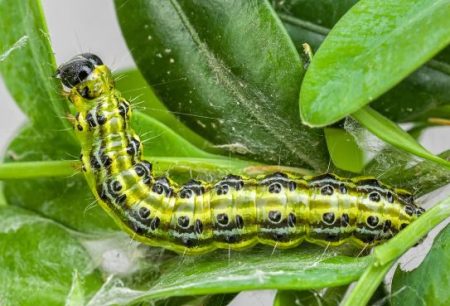
Although not dangerous to people, the box tree moth (Cydalima perspectalis Walker) is a major pest for boxwood plants (Buxus spp.) in Canada. It travels 5–10 km a year as it passes through boxwood shrubs that are afflicted. If you see any indications of an infestation outside of Ontario, report it. It is controlled in Canada and is presently found in Ontario, specifically between Toronto and Windsor and Toronto and Niagara, and it only affects boxwood bushes.
6. Genista Broom Moth Caterpillar (Uresiphita reversalis)
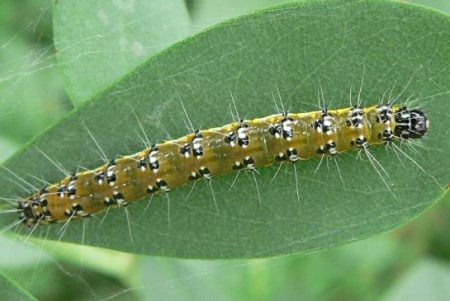
Uresiphita reversalis, the genista broom moth, is sometimes referred to as the sophora worm and genista caterpillar. With a dark patch on each upper wing, the moths have light to medium brown coloring. Yellow or orange in color, the hindwings have some brownish-gray coloring along their margins. Up to roughly 70 eggs can be laid in a batch by a female.
7. Silver-Spotted Skipper Caterpillar
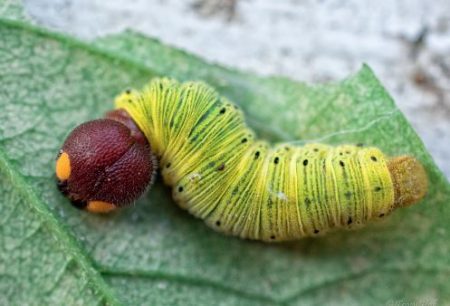
Silver-Spotted Skipper Caterpillar, also known as Epargyreus clarus, is a common butterfly in North America. The smooth, slender green-yellow bodies of these caterpillars may or may not have noticeable dark green stripes. They have a characteristic neck collar that adorns their reddish-brown to black heads. They have bright orange prolegs and can reach a length of five centimeters. They eat a variety of plants, such as false indigo bush, black locust, butterfly pea, wisteria, and American hog peanut. These caterpillars, which are frequently seen in meadows and marshes, are eaten by wasps, ants, frogs, and spiders. With the exception of the area from western Texas to the Great Basin, they are frequently observed throughout North America.
8. Angle-Lined Prominent Caterpillar
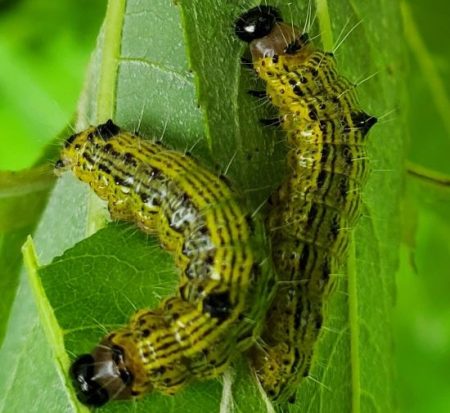
The Clostera inclusa, also referred to as the Angle-Lined Prominent Caterpillar, changes into a moth. These caterpillars, which range in color from light brown to lavender-gray, have glossy black heads and can grow up to 4.4 cm in length. They are known to be gregarious, with young individuals skeletonizing host plant leaves while hiding in silken tents. They spend their winters in pupae form inside a beautiful silken cocoon. When they get bigger, they eat the entire leaf. In 1831, this species was first described. They are found in many parts of North America, including Florida, Illinois, New York, Oklahoma, Oregon, South Carolina, Colorado, Arkansas, Georgia, New Hampshire, North Carolina, Pennsylvania, and Virginia, and are easily recognized by their distinctive black heads.
9. European Puss Moth Caterpillar (Cerura vinula)
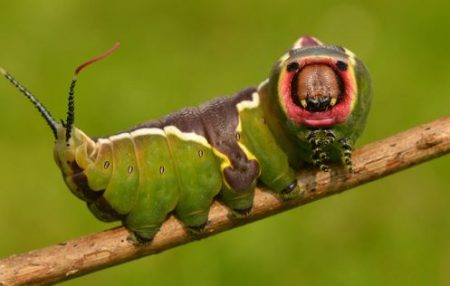
The Puss Moth is a small, native European moth with 5.5–7.5 cm wingspan. When the tree buds open in April or May, the moths usually come out. Large, impressive, and very simple to raise are caterpillars. Willow, Birch, Poplar, Cherry, Oak, Hawthorn, and undoubtedly many more plants are examples of hosts. The caterpillars build a hard cocoon out of tree bark, where they hibernate during the winter.
10. Contracted Datana Moth Caterpillar
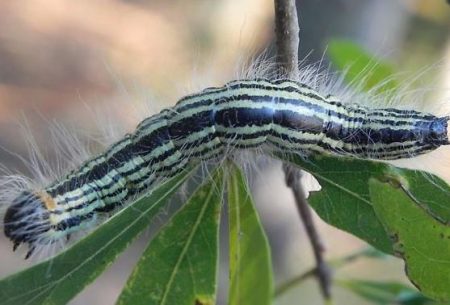
The Datana contracta, also known as the Contracted Datana Moth Caterpillar, is 4.5 centimeters long. Its long white hair covers its black body with a middorsal stripe, four cream, and three black stripes. Its orange thoracic shield and black head are its main sources of food. It also consumes the leaves of oaks, hickories, blueberries, sycamore, and witch hazel. It is usual to find this species in a wide area that stretches from Florida to Maine and west to Wisconsin and Arkansas. It has been observed in Alabama feeding on sawtooth oak and water laurel.
What is the lifecycle of green caterpillars with black heads?
The lifecycle of green caterpillars with black heads follows a well-defined pattern, encompassing distinct developmental stages. It all begins with the laying of eggs by adult butterflies or moths, leading to the emergence of tiny caterpillars. These caterpillars, with their characteristic green bodies and distinctive black heads, embark on a phase of voracious feeding, consuming ample vegetation to support their rapid growth.
As they continue to feed and grow, the caterpillars molt several times, shedding their exoskeletons to accommodate their increasing size. This larval stage persists until they reach full maturity, after which they enter the pupal stage, encasing themselves in a protective cocoon. Within this cocoon, a remarkable transformation takes place, leading to the emergence of adult butterflies or moths, thus completing the lifecycle of these fascinating green caterpillars with black heads.
What is the significance of the black head on green caterpillars?
The black head of green caterpillars holds a significant role in the realm of entomology, serving as a key distinguishing feature for various species. This distinctive trait aids researchers and enthusiasts in the identification and classification of different types of caterpillars, facilitating a better understanding of their ecological roles and behaviors within their respective habitats.
By recognizing and studying the variations in the black head patterns, researchers can delineate specific species and further delve into the intricate nuances of their life cycles, feeding behaviors, and interactions with their surrounding environment. Consequently, the black head of these caterpillars not only serves as a visual marker for differentiation but also acts as a vital clue in unraveling the complexities of their intriguing existence in the natural world.
People Who Read This Also Read:

